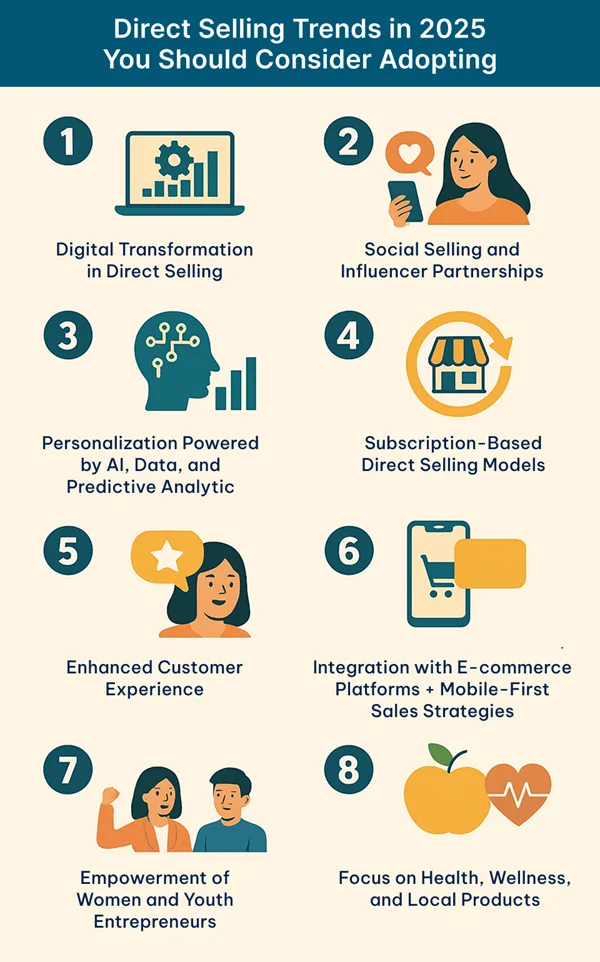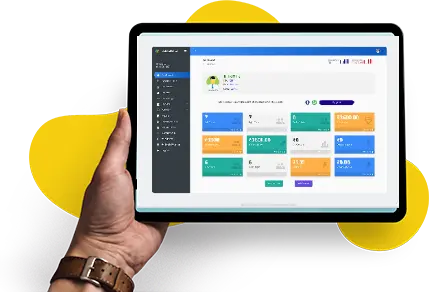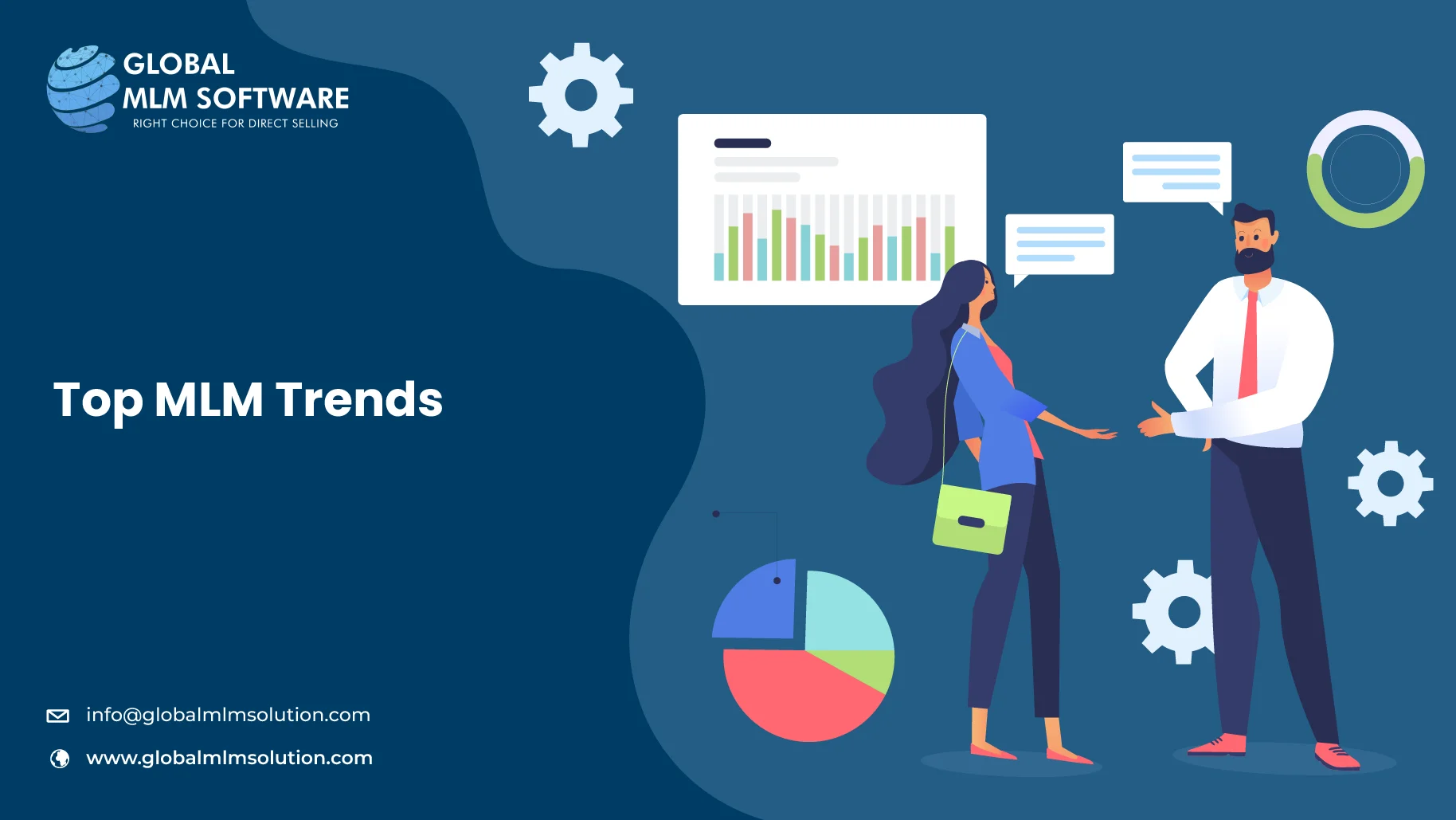If you lead or want to lead a direct selling company, watching trends isn’t optional; it’s a strategic requirement. The market is moving fast. Customer behaviors, technology, and regulatory expectations shift in parallel, and the companies that win are those that read the signals early, test wisely, and adapt without losing their core economics.
This blog lays out the emerging trends in direct selling and pairs each trend with practical implementation steps you can use immediately. What to test first, which KPIs to track, and how to align distributor incentives and compliance—we’ve covered everything!
So, read, analyze, and pick the ones that align with your MLM brand’s long-term goals.
This Article Contains:
Direct Selling Trends in 2025 You Should Consider Adopting
We have picked the most crucial direct selling trends for 2025 that you should be following to stand strong in the current market.

1) Digital Transformation in Direct Selling
Digital transformation in direct selling isn't just a catchphrase; it's the foundation of operations that is revolutionizing the way distributors and multilevel marketing companies locate, acquire, and keep clients.
AI, automation, and omnichannel platforms now connect lead generation, onboarding, commissions, and customer service into a single, measurable flow.
MLM tools with automated commission engines calculate and pay overrides.
Virtual onboarding replaces travel-heavy training.
Mobile dashboards give sellers real-time KPIs.
AI-powered chatbots handle routine support so humans focus on high-value conversations.
Top MLM companies, such as doTERRA, moved their Global Convention online and reached tens of thousands of attendees in 2020. They have been organizing it online ever since, proving that virtual gatherings can scale community and training without geographic limits. Similarly, Amway now runs virtual leadership conferences and hybrid events to keep distributors engaged year-round.
Here’s how you can participate in the digital transformation of direct selling:
Consolidate CRM, LMS, and MLM commission software so distributor data remains single-source, reduce manual errors, and speed payouts.
Run small, measurable live-stream tests on social platforms. You can take it one step ahead by integrating direct checkout options in your live stream so interested people can purchase products right away.
Build short automated nurture flows (SMS + email) that qualify digital leads before handing them to a distributor. This saves time and raises appointment-to-sale rates.
2) Social Selling and Influencer Partnerships
Social selling is the practice of using social platforms to discover prospects, build relationships, and close sales-often by combining content, conversation, and commerce in the same flow.
Influencer partnerships are paid or barter collaborations where creators amplify product stories to their audiences. When done right, they add reach, context, and trust that paid ads alone can’t match. Together, they’re central to social selling trends 2025, which emphasise authenticity, short-form video, and seamless in-platform transactions.
Why does it matter? Because social proof short-circuits skepticism. According to HubSpot, 87% of sellers say social selling has been effective for their business. At the same time, consumers don’t fully trust social shopping yet.
That’s where user-generated content (UGC) becomes essential. About 87% of businesses report that UGC increases sales, and 92% say it raises brand awareness. In short, people buy from people; influencers and UGC provide the human proof social shoppers want.
Practical ways distributors and MLM companies can use these methods are:
Partner with micro-influencers for authentic demos and discount codes; micro-creators often drive higher engagement per dollar.
Support UGC content where distributors themselves can create UGC content and brands can feature the best posts in paid ads and landing pages. Or, MLM brands can partner with UGC creators for such collaborations.
Use live streams and shoppable posts to convert interest into immediate purchases, then follow up with personalized messages from the independent seller.
Track performance by linking affiliate codes and short URLs to each influencer so you can measure real sales, not just vanity metrics.
3) Personalization Powered by AI, Data, and Predictive Analytics
Personalization is no longer optional; it’s how top direct selling companies scale human relationships without losing relevance. The Global AI Direct Selling Market is projected to grow from USD 14.5 billion in 2024 to about USD 625.1 billion by 2034 at a CAGR of 45.7% (2025-2034).
In 2024, North America led with a market share of ~34.7% (USD 5.03 billion), a clear indication that data-led selling has already reached an industrial scale.
AI in direct selling enables you to turn raw behavioral data into precise actions: who to contact, what offer will convert, and when to push for a close. Here are some actionable and direct-selling-focused moves you can implement now:
Centralize data: Feed your CRM with sales, web behavior, ad clicks, chat logs, and distributor activity. A single source of truth is non-negotiable.
Deploy predictive lead scoring: Use historical outcomes to score new leads automatically. Route high-score prospects to your best distributor within a set SLA (for example, less than 2 hours). This increases appointment-to-sale rates.
Personalize offers dynamically: Use recommender engines to surface the right product bundles (replenishment, upsell, subscription) in distributor scripts, emails, and ads.
Automation: Start automating qualification with AI chat or short SMS flows. Chatbots collect intent and qualify before a human distributor follows up, which means fewer cold calls and more warm conversations.
Use churn prediction to retain customers: Trigger targeted retention flows or distributor outreach when a customer shows lapse signals.
Measure and iterate: Continuously track uplift in conversion rate, CAC (Customer Acquisition Cost), AOV (Average Order Value), and LTV (Customer Lifetime Value) attributed to AI-driven actions. Also, run controlled A/B tests before full roll-out.
Additionally, you can deploy modern, AI-powered MLM software. The best ones are equipped with integrations such as predictive scoring, automated commission engines, mobile dashboards for distributors, and analytics.
This reduces cost and effort, as you'll have everything in a single tool rather than stitching tools together. You may choose software that exposes APIs, supports real-time routing, and offers explainable models (so distributors understand the “why” AI made a recommendation).
4) Subscription-Based Direct Selling Models
A subscription model in direct selling turns one-off purchases into predictable, recurring revenue while giving distributors a fresh way to engage customers. Instead of asking a buyer to reorder every month, the distributor offers an auto-replenish option. Thus, subscriptions make ordering simpler for the customer, provide steadier revenue for the company, and create a new income stream for the distributor.
Here's an example/application that you can use as a basic framework:
Suppose your beauty cream retails at $17 as a single purchase. To make the subscription sound more appealing, you can offer a discounted price of $15 per month if the customer signs up for auto-delivery. That $2 discount becomes the customer incentive; the convenience and minor savings become the distributor’s selling point.
And you can definitely adopt something more unique, like adding bundles and tiers, like Netflix and Amazon, for upsell. You can create subscription tiers, such as:
Basic subscription: Single product delivery at $15/month (small discount).
Basic Plus Subscription: A bundle of two/three products, cream + serum bundle, $28/month (larger bundled discount).
Premium Subscription: Four or more products bundle + sample kit, $45/month + priority shipping.
Now, customers and the company can profit from this, but what about distributors? What's the benefit for them?
You can introduce subscription-specific metrics in the compensation plan so they get better commissions when getting subscription orders. Here's an example:
You can give a fixed percentage (let's say, 10%) of the monthly subscription value paid to the distributor for each active subscriber.
Apply a PV multiplier to subscriptions (for example, subscription PV = single sale PV × 1.2) so subscriptions contribute more to rank and bonuses.
Or, you can create different PV for subscriptions that feed your compensation system. For example, you can keep Basic = 10 PV, Plus = 18 PV, and Premium = 30 PV. Higher PVs mean higher commission eligibility and rank acceleration for the distributor.
Reward bundle subscriptions with a one-time bonus, paid trip, or any other incentive to encourage larger baskets.
You can frame these terms clearly in the MLM plan so distributors see the direct link between presenting subscriptions and earning potential.
5) Enhanced Customer Experience
“Customer-obsessed” organizations reported 41% faster revenue growth than those that aren’t. (Forrester)
The statistic above highlights the importance of a hyperactive customer response team. When your direct selling companies prioritize world-class support, they convert one-time buyers into loyal customers and give distributors a stronger proposition to sell.
No matter in which state or country your business is, support quality is a top driver of loyalty and repurchase intent. So, building a seamless, measurable customer experience should be a strategic priority.
To implement it, you can use these basic markers:
Rapid, omnichannel response: Offer live chat, SMS, email, and phone support with clear SLAs (e.g., chat less than 1 hour; email less than 24 hours). Providing consistent, fast responses reduces friction and protects distributor credibility.
Easy returns and transparent policies: A simple returns flow (prepaid labels and online refunds) reduces buyer anxiety and shortens the feedback loop for product issues. For best implementation, always publish policies clearly on product pages, distributor collateral, and invoices.
Proactive engagement: Use order and subscription data to trigger replenishment reminders, how-to guides, and refill discounts. These can be delivered by the company, but branded for the distributor to follow up personally.
Competitive and transparent pricing: Ensure you add subscription and bundle pricing transparently in brochures and websites. Provide distributors with a clear comparison sheet (single vs subscription vs bundle) so they can present benefits quickly.
Human + automated support balance: Automate routine tasks, such as FAQs, order status, and simple refunds, so human agents and distributors focus on escalation and relationship building.
You can also use tech to implement these systems. You can integrate MLM CRM, MLM ERP, MLM order management, and MLM ticketing systems to unify customer, order, and distributor records.
6) Integration with E-commerce Platforms + Mobile-First Sales Strategies
Mobile is where most people spend their time shopping - we're not saying this, but numbers are. 76% of U.S. adults use a smartphone to shop or buy online, and 32% do so weekly or more. At the same time, direct e-commerce sales in the U.S. jumped from $128 billion in 2021 to about $182 billion in 2023.
Those two facts together make the case obvious. Direct selling companies must create robust e-commerce platforms with mobile-first experiences to capture demand and keep distributors productive.
It matters now because MLM e-commerce platforms with mobile-friendly designs provide reliable checkout, payment processing, inventory management, and order management.
However, for direct selling companies, there are extra requirements: attribution and commission tracking. Every mobile sale or micro-conversion must map back to the distributor who sourced or referred the customer in real time. Without that link, you lose trust and incentive.
Here's how you can give your brand the benefits of a mobile-ready direct selling e-commerce:
Custom storefronts: Provide distributor storefronts that are mobile-optimized and shareable. Give each distributor a short URL, QR code, and one-tap social share so customers can buy instantly from their store and earn credits.
Make checkout frictionless: Reduce form fields, enable Apple Pay / Google Pay / one-click payments, and show price, shipping, and PV/commission badges clearly. Small UX changes cut abandonment dramatically.
Integrate MLM e-commerce with your CRM: Orders, returns, subscription status, and commission events should flow into a unified data layer so distributor dashboards show real-time earnings.
Mobile-optimized: Use progressive web apps (PWAs) or responsive native apps to improve speed, offline caching, and push notifications for replenishment or limited offers.
Use social selling: Support social commerce and shoppable video. Let distributors embed shoppable links in live streams, short videos, and stories, and ensure the sale credits the distributor.
Continuously measure mobile-specific KPIs: Monitor mobile conversion rate, cart abandonment, time-to-purchase, share-to-cart ratio, and mobile LTV. Attribute these back to distributor activity so you can optimize rewards.
7) Empowerment of Women and Youth Entrepreneurs
One of the most defining shifts in direct selling is the growing role of women. The flexibility, low entry barriers, and performance-driven rewards make this model appealing to people who want to balance personal goals with professional growth.
In fact, in the United States, more than 61% of direct sellers are women, most of them married and living in households with three or more people. This reflects how direct selling is often chosen as a way to contribute financially without compromising family responsibilities.
With direct selling, women are earning, building leadership skills, expanding networks, and establishing a sense of financial independence. Many MLM companies, such as AVON, Mary Kay, and doTERRA, don't differentiate between men and women. They are providing equal levels of training and opportunities to women globally.
8) Focus on Health, Wellness, and Local Products
By product, the health & wellness segment accounted for the largest share of 35.5% of the direct-selling market in 2024. This figure makes the trend unmistakable: wellness, nutrition, and eco-friendly product lines now dominate direct selling.
The following factors pushed direct-selling wellness sales hard through 2020-24:
Post-pandemic health priorities.
Rising chronic conditions.
Busier lifestyles that favor convenient supplements and ready-to-use wellness solutions.
Greater consumer interest in clean, sustainable personal care.
At the same time, the cosmetics and personal care category is the fastest-growing segment in the direct-selling mix, forecast to expand at roughly 7.4% CAGR from 2025-2030. Innovations in sustainable/green cosmetics, strong skincare routines, and new product formats (travel-size, multi-use products) are major tailwinds.
Therefore, if you're planning to enter the direct selling industry, you should:
Prioritize category choices: Place vitamins, targeted supplements, functional foods, clean-label skincare, and eco household products at the front of your catalog because this is where demand and margin are concentrated.
Localize sourcing and messaging: Use locally produced botanicals, regionally relevant formulations, or “made in” credentials to appeal to customers who value traceability.
Train distributors on claims and compliance: Health and wellness products require careful and evidence-based positioning. Therefore, equip your distributors with approved MLM scripts, citations, scientific claims, and a complaint-handling process to avoid regulatory risk.
Use sustainability as a brand lever: Green packaging, cruelty-free certification, and ingredient transparency attract higher willingness-to-pay and drive repeat purchases, especially in cosmetics.
If your company matches product quality, distribution incentives, and compliance training to these trending MLM segments, chances are, dynamics will capture recurring revenue and stronger customer loyalty.
Conclusion
Now you know where direct selling is pivoting, toward digital-first distribution, data-powered personalization, subscriptions, and experience-led retention. Analyze the scope and economics of each trend for your product mix and distributor network, then adopt the few that align with your margins and capacity.
Brands such as Amway, Herbalife, and LifeVantage have already shifted; copy their intent, not their playbook. Pick wisely, pilot quickly, and scale what demonstrably improves conversion, retention, and distributor economics–that’s how you stay ahead.
FAQs
1. Why is it important to understand direct selling trends?
It’s important to understand direct sales industry trends because only then can you keep up with the customer preferences and market benchmarks. It helps you stay relevant in the industry and keep scaling effortlessly.
2. How can businesses leverage direct selling trends in 2025?
You can begin by conducting an audit of distributor preparedness and product-market fit, selecting one or two high-impact trends, conducting small, quantifiable pilots, and connecting distributor incentives and compliance to specific KPIs. Measure CAC, conversion, LTV, and PV contribution, iterate quickly, and scale only those combinations that increase distributor earnings and unit economics.
3. What is the future outlook of direct selling beyond 2025?
Direct selling appears to have a bright future, as the sector is expected to expand at a compound annual growth rate (CAGR) of 6.7% between 2025 and 2030. By 2030, the market will have grown from USD 223.82 billion in 2024 to USD 328.26 billion at this rate.
Disclaimer: Global MLM Software does not endorse any companies or products mentioned in this article. The content is derived from publicly available resources and does not favor any specific organizations, individuals or products.









